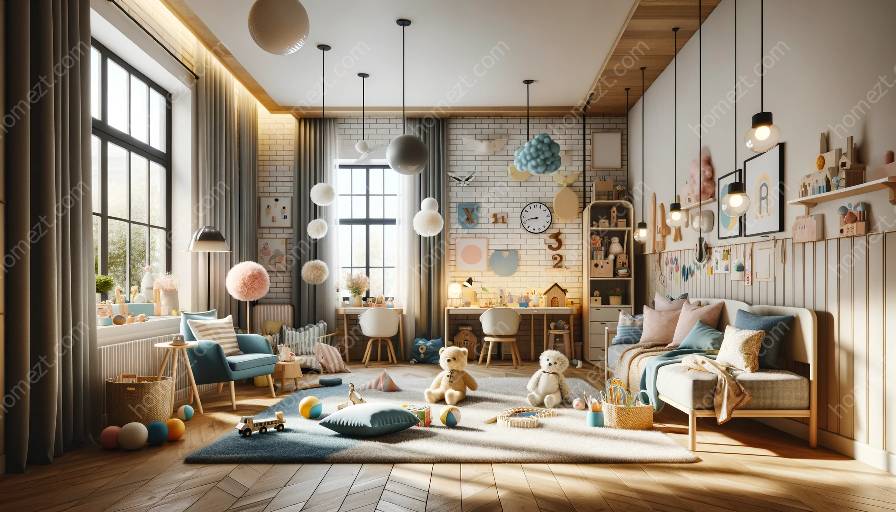Incorporating educational elements into a children's room design is a great way to foster learning and creativity in a space where a child spends a significant amount of time. From interactive features to themed decor, there are numerous ways to make learning fun and engaging for kids while also adding style to the room. In this article, we'll explore some creative and attractive ideas to incorporate educational elements into a children's room design that are compatible with interior design and styling.
1. Interactive Wall Murals
One creative way to incorporate educational elements into a children's room design is through interactive wall murals. These murals can feature educational themes such as alphabet letters, numbers, or scenes from nature. Consider choosing a mural that allows kids to interact with it, such as a magnetic alphabet wall where kids can arrange letters to form words or sentences. This not only adds an educational element to the room but also serves as a visually appealing and interactive feature.
2. Themed Reading Corners
Creating a themed reading corner within the children's room is a fantastic way to promote literacy and a love for reading. Choose a theme that the child is interested in, such as outer space, under the sea, or a magical forest, and incorporate elements such as cozy seating, a bookshelf with age-appropriate books, and themed decor. This not only encourages reading but also enhances the overall design of the room with a visually appealing and educational space.
3. Educational Play Areas
Integrating educational play areas into the children's room design can provide opportunities for learning through play. Consider incorporating elements such as a miniature kitchen for pretend cooking, a market stall for learning about fruits and vegetables, or a mini science lab for conducting simple experiments. These areas not only add educational value to the room but also enhance the overall design with themed play elements.
4. Learning Wall Displays
Creating learning wall displays within the children's room is a visually appealing way to incorporate educational elements. Use wall space to display educational posters, maps, or charts related to topics such as geography, science, or language. Incorporate colorful and informative displays that are both educational and decorative, adding depth to the room's design while promoting learning.
5. Interactive Learning Desks
Investing in interactive learning desks or tables for the children's room can be a great way to incorporate educational elements into the design. Look for desks with built-in features such as interactive touch screens, storage for educational materials, or adjustable heights to accommodate various activities. These desks not only provide a dedicated space for learning but also contribute to the overall design and functionality of the room.
6. Creative Wall Decals
Using creative and educational wall decals can add visual interest and educational value to the children's room design. Choose decals that feature elements such as maps, solar systems, or inspirational quotes to provide educational content while enhancing the room's aesthetic appeal. Wall decals are easy to apply and remove, making them a versatile and attractive option for incorporating educational elements.
7. Personalized Learning Zones
Creating personalized learning zones within the children's room allows for individualized educational spaces. Consider incorporating areas dedicated to specific subjects or interests, such as a math corner with interactive tools, a language arts area with word games and puzzles, or a creativity corner for arts and crafts. This personalized approach not only promotes learning but also adds character and depth to the room's design.
8. Educational Storage Solutions
Integrating educational storage solutions into the children's room design can be both practical and visually appealing. Use storage bins, shelves, and containers that are labeled with educational themes such as colors, shapes, or subjects. This not only helps keep the room organized but also provides educational reinforcement through visual cues and themed storage options.
9. Inspiring Art and Creativity Spaces
Inspire creativity and artistic expression by incorporating art and creativity spaces within the children's room. Set up an art easel, supply a variety of art materials, and display inspirational artwork to encourage creativity. Incorporate educational elements by showcasing famous artists or art movements, and by providing educational materials related to different art forms.
10. Interactive Learning Technology
Integrating interactive learning technology into the children's room design can provide educational content in an engaging and modern way. Consider incorporating devices such as interactive whiteboards, educational tablets, or educational gaming systems that offer age-appropriate learning experiences. These tech-focused elements not only contribute to the room's design but also provide educational value through interactive learning.
By incorporating these creative and attractive ideas into a children's room design, it's possible to create a space that fosters learning, creativity, and personal development. These elements not only enhance the educational aspects of the room but also contribute to the overall interior design and styling, resulting in a visually appealing and engaging space for children to learn and explore.


























